Helping children learn to read is a critical part of early education. One practical way to achieve this goal is by using apps to teach kids to read, which combine phonics, stories, and games.
These apps create an interactive learning experience that keeps children engaged. Parents and teachers can use them as valuable tools to build confidence and improve literacy skills.
Why Use Apps to Teach Kids to Read?
Apps provide new ways to engage children in reading. They create fun and structured learning experiences that parents can easily monitor.

Interactive Learning Benefits
Reading apps make lessons dynamic and adaptive. They adjust to each child’s pace and ability. Animations and rewards keep children motivated. Parents can track results to stay involved.
This makes it easier to measure consistent progress. Children benefit from learning that feels both fun and educational.
Phonics and Vocabulary Support
Apps strengthen phonics and vocabulary foundations. They include clear, step-by-step lessons for beginners. Children repeat exercises until they build confidence.
This makes learning smoother and less stressful. Regular practice creates familiarity with reading rules. Consistency helps children transition to independent reading.
Comprehension and Story Engagement
Interactive stories improve comprehension skills. Kids connect with characters and follow narratives. These features help children understand context better.
Regular practice develops stronger reading habits. Exposure to different storylines builds creativity. Consistency with stories enhances long-term literacy growth.
Motivation and Consistency
Gamified rewards encourage consistency. Children practice because they enjoy the experience. Daily sessions are short but effective. This builds routine and lasting literacy progress.
Consistency ensures children make steady improvement. Over time, these habits create strong and confident readers.
Key Features to Look for in Reading Apps
Parents should know what makes a reading app effective. The right features ensure lessons are both fun and useful.
Look for apps that balance entertainment with education. This helps children stay consistent and make steady progress.
Important Functions in Reading Apps
Here are the most valuable features to check before downloading:
- Phonics Lessons: Structured steps for early reading skills.
- Interactive Stories: Engaging narratives to improve comprehension.
- Progress Tracking: Dashboards to monitor growth.
- Gamified Rewards: Stickers or points to motivate kids.
- Age-Appropriate Design: Content suitable for specific learning levels.
These functions make reading apps practical for home and classroom use.
Best Apps to Teach Kids to Read
Several apps stand out for their design and effectiveness. Each one offers unique features for children at different stages.
Parents can choose based on their child’s age and learning style. Below are the most recommended options.
ABCmouse 2
ABCmouse is a complete learning platform with a strong focus on reading. It offers step-by-step phonics lessons supported by games and songs.
The app also offers a comprehensive curriculum that encompasses additional subjects. Children enjoy earning rewards as they progress through lessons.
ABCmouse is available for download on Google Play and the App Store, making it easy for parents to install on both Android and iOS devices.
Homer
Homer is designed to create personalized learning journeys. It adapts lessons based on each child’s strengths and weaknesses.
The app combines phonics, sight words, and comprehension exercises. Kids aged 2–8 benefit most from its interactive content.
Homer can be accessed on Google Play and the App Store, so families can download it directly to their preferred device.
Khan Academy Kids
Khan Academy Kids offers free and ad-free literacy tools. It includes reading, math, and social skills lessons in one platform. The app emphasizes storytelling and comprehension with colorful characters.
Parents value its high-quality resources without cost barriers. Khan Academy Kids is available for free on Google Play and the App Store, allowing for quick download across various platforms.
Reading Eggs – Learn to Read
Reading Eggs uses phonics to build early literacy. It offers hundreds of interactive books and structured lessons. Children progress through levels designed for ages 3–13.
The mix of lessons and rewards keeps them motivated. Reading Eggs is downloadable on Google Play and the App Store, ensuring access for both Android and iOS users.

Free Vs. Paid Reading Apps
Parents often want to know if free options are sufficient. This section explains the differences and helps families choose wisely.
Benefits of Free Apps
Here are some clear benefits parents can expect from free reading apps. They provide simple yet effective tools without financial barriers.
- Free platforms provide basic literacy skills and accessible resources.
- They reduce cost barriers for families.
- Khan Academy Kids is an example of strong free content.
Parents can rely on it for early literacy support.
Advantages of Paid Apps
Here are some reasons parents may choose paid reading apps. They provide added depth and long-term benefits for children’s literacy.
- Paid apps include broader libraries and structured paths.
- They provide more depth and longer-term growth.
- ABCmouse and Reading Eggs are strong paid options.
They offer comprehensive lessons across reading levels.
Budget Considerations
Parents should consider the budget and goals before choosing. Free apps can start the journey effectively. Paid apps may be better for long-term structured learning. The choice depends on family priorities.
Consistency Matters Most
Both free and paid apps can be effective when used consistently. Regular practice makes the biggest difference.
Children benefit from steady, daily sessions. Consistency builds habits and lasting literacy skills.
Expert Tips for Parents
Experts recommend balancing app use with offline reading. Daily screen time should be limited and monitored.
Parents should read with their children to reinforce lessons. Rewards and encouragement keep children motivated to practice.
- Combine reading apps with physical books for balance.
- Set screen time rules to avoid overuse.
- Read aloud with your child daily.
- Use rewards like stickers to celebrate progress.
Following these tips ensures apps support, not replace, real-world reading.
Final Words: Start Building Literacy with Apps Today
Apps to teach kids to read provide valuable tools for early education. They combine phonics, interactive stories, and progress tracking to support learning.
Parents and teachers play a key role in guiding consistent use. Begin with one app and integrate it into daily reading routines to build strong literacy skills.